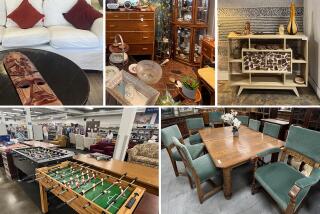Space Toys From ‘50s Rocket in Value
- Share via
Collectors now want anything that suggests space travel. Of particular interest are the TV shows and movies that depict such interplanetary events. Everything from “Buck Rogers” to “Babylon 5” is being collected.
To collect space memorabilia, you need to be able to recognize fictional symbols and characters.
Space toys of the 1950s are gaining value. The most valuable of such collectibles are toy rocket ships, ray guns and robots, Halloween costumes, figurines, board games, books, lunch boxes and dishes.
Memorabilia from actual events, such as the Apollo missions and the Mars exploration by Sojourner, have also become important collectibles.
*
Question: More than 50 years ago, I received a blue-and-white ceramic pitcher from a friend in England. It is decorated with Asian-style landscape scenes. The shield mark on the bottom pictures a church. The words in the mark include “Ming” and “T.G.G. & Co. Ltd., England.”
*
Answer: Your pitcher was made by T.G. Green & Co. Ltd., a pottery that opened in 1864 in the town of Church Gresley in Derbyshire, England. The pottery made earthenware and stoneware items. Your pitcher was part of the company’s Ming pattern.
The mark you describe was used beginning in 1892. Your pitcher probably dates from around the turn of the century.
*
Q: I have an original G.I. Joe doll from 1964. I’m curious about the origin of the term “G.I.”
*
A According to the Dictionary of American Slang, the history of “G.I.” goes back to 1915-1920. Army bookkeepers jotted the initials G.I. on their ledgers indicating items made of galvanized iron.
By 1935, the Army was using “G.I.” to refer to anything issued to its soldiers. The initials then stood for “government issue” or “general issue.”
During World War II, the acronym was extended to refer to anything associated with Army life and to the soldiers themselves, whether they served in the Army or another branch of service.
*
Q: I just bought an ornate mahogany-and-metal bird cage at an auction. It has a large central turret and four smaller ones, four small doors and a pull-out tray. It is attached to its own table and stands 6 feet tall. Can you give me any information?
*
A: Elaborate bird cages were popular among the English upper classes during the 19th century.
Your cage is in a style popular during the Regency period, about 1810-1862. At the time, Asian curves and cupolas influenced English architecture.
Antique bird cages are rare and expensive. Reproductions are being made in Asia and sold in the United States. The description of your cage leads us to suspect it might be a reproduction.
*
Q: We inherited a beautiful grandfather clock that keeps perfect time. The names “J. Carswell” and “Kilmarnock” appear on opposite sides of the clock face. Above the face, there’s a painting titled “Burns at the Plough.” We were told it was made by the makers of Big Ben. Could that be true?
*
A: Your clock was made by either Joseph Carswell, who worked in Hastings, England, in the middle of the 18th century, or John Carswell, who worked in London the first half of the 19th century.
Kilmarnock is the town in Scotland where Robert Burns published his first book of poetry in 1786. Burns, the national poet of Scotland, is pictured in the painting on your clock, which is worth thousands of dollars if it has its original works.
Big Ben, the tower clock of the Houses of Parliament in London, was designed about 1851 by Edmund Beckett Denison. Clockmaker Edward John Dent and Sir George Airy, the royal astronomer, assisted Denison. Originally, the name Big Ben referred only to the clock’s huge bell.
*
Q: The popularity of the movie “Titanic” made me dig through my attic for a book I remembered: “Sinking of the Titanic: The World’s Greatest Sea Disaster.” It is copyrighted 1912, the same year the ocean liner sank. Is it worth much?
*
A Times weren’t so different in 1912. Books about disasters hit the market quickly.
Depending on your book’s condition, it would sell for about $75.
*
Q: I have a large copper washing machine made by the 1900 Washer Co. of Binghamton, N.Y. I want to sell it but don’t know the value.
*
A: Old copper washing machines are difficult to sell because they are so large and heavy. Sometimes one can be sold to an appliance store as a window display. Many are sold as scrap copper.
A local historical society might be interested in it as a donation.
For a copy of the Kovels’ 1998 leaflet listing 153 books and pamphlets that are price guides for all kinds of collectibles and antiques, send $2 and a self-addressed, stamped (55 cents) No. 10 envelope to: Price Guides for Antiques and Collectibles, Kovels, P.O. Box 22900, Beachwood OH 44122.
(BEGIN TEXT OF INFOBOX / INFOGRAPHIC)
Current Prices
Current prices are recorded from antiques shows, flea markets, sales and auctions throughout the United States. Prices vary because of local economic conditions.
* Avon bottle, Stanley Steamer, 1978: $10.
* Cast-iron pencil holder, bulldog, World’s Fair, 1933: $70.
* Lace bobbin, bone, turned design, dyed green and red, 1850s, English: $95.
* Kool cigarettes World War II store sign, Kool penguin as sentry carrying rifle, “Keep alert--smoke Kools,” 12x18 inches: $135.
* Victorian doll furniture, cast iron, German, painted orange, circa 1890, six pieces, couch, two chairs, footstool and two tables, 4 inches: $210.
* Kentucky Derby glass, aluminum, 1940: $455.
* Chintz vegetable dish, covered, Old Cottage pattern, ascot shape, round with flat rim, 10 inches: $510.
More to Read
Sign up for The Wild
We’ll help you find the best places to hike, bike and run, as well as the perfect silent spots for meditation and yoga.
You may occasionally receive promotional content from the Los Angeles Times.






